Market Trends of Asia-Pacific Smart Home Industry
HVAC Systems are Among the Most Significant Contributors to the Market
- The Asia-Pacific HVAC market is surging, driven by rising temperatures due to global warming and the booming construction sector. This, in turn, is spurring technological advancements in HVAC systems to enhance efficiency.
- As a result, key players in the market are largely focusing on developing intelligent, automated, and eco-friendly HVAC solutions. For instance, integrating IoT sensors allows these systems to collect real-time data, boosting operational efficiency. The adoption of IoT technology in smart HVAC solutions is revolutionizing the sector enhancing functionality and performance.
- Moreover, the industry is rapidly moving toward more intelligent, automated, and eco-conscious HVAC systems. With the advent of AI-based solutions and the integration of IoT in smart HVAC, the industry is witnessing a prominent shift towards energy efficiency, meeting the escalating demand for such systems.
- The surging demand for energy-efficient systems further bolsters automation in the HVAC sector. Notably, the International Energy Agency (IEA) predicts a remarkable surge in AC sales in Southeast Asia, from 40 million units in 2017 to 300 million by 2040, with Indonesia accounting for half of this figure.
- However, this growth comes with challenges. Without proactive measures to promote energy-efficient units, the region's cooling needs could necessitate an additional 200 GW of power generation by 2040. Cooling demands may contribute up to 30% of the region's peak electricity consumption. Recognizing these concerns, governments are increasingly focusing on energy-saving initiatives, further propelling the adoption of smart HVAC systems.

China Holds the Major Share of the Market
- Chinese consumers increasingly embrace the concept of 'smart homes' as a wave of smart devices floods the market. Brands are placing a strong emphasis on 'smartness' in their home appliances. Through strategic public-private partnerships and targeted technological innovations, China has effectively implemented smart city infrastructure in numerous major metropolises, extending its impact to the residential sector.
- Consequently, various smart home products and household equipment have seamlessly integrated into daily life in Chinese cities alongside smartphones and watches. These include smart door locks, doorbells, kitchen appliances, cat litter boxes, and intelligent sweeping and vacuum robots.
- Moreover, manufacturers of smart home devices in China are increasingly harnessing digital technologies to revamp their products. For example, air conditioners with self-learning capabilities, adjusting room humidity and temperature based on user habits, are now commonplace.
- Notably, with the rise of the construction sector, consumer enthusiasm for smart home products remains high. As per Yakai, Chinese people have 4.1 per household, the highest in the world, compared with a global average of 3.5. In addition, one-third of Chinese respondents represent 27% globally, as they have five or more such products. All these factors present a positive growth prospect for smart homes in China.


